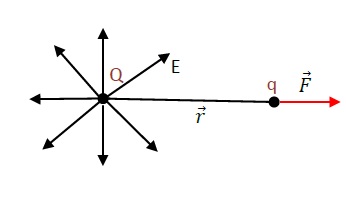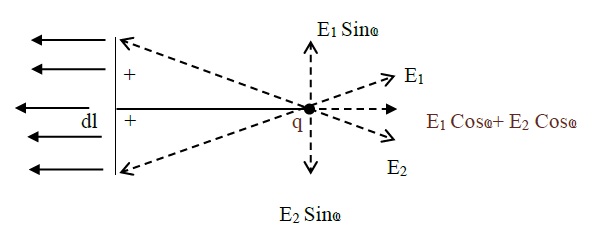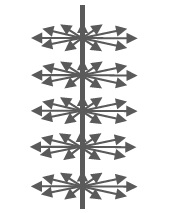Electric Field Distribution in Point & Line Charge
Description:
Point charge −
When the matter containing charge is in shape of a point then it is called as a point charge.
To measure electric field at a particular distance ‘r’ due to the matter containing charge ‘Q’, a test charge is put at a distance ‘r’ from the source charge ‘Q’. The test charge starts to experience force of repulsion in the line joining the two charges. This force per unit charge gives electric field.
The vector representation of force is shown in the figure.

This field applies same repulsive force in all the direction. This shows that, the shape of electric field due to the point charge is a “radial field” .At a distance ‘r’ electric field vector is given by −
E→ = 14πε0Qr2r̂qQ
Here the electric field is in the direction of ‘r’.
Line Charge −
Charges distributed in shape of a straight line is called line
Note −
Resultant electric field due to a line charge is always less than the electric field due to a point charge.
In line charge, charges are distributed all over the line due to which some of the components of electric field cancel each other which does not happen in case of a point charge. So, electric field due to a line charge is always less
Line Charge

The resultant shape of electric field at every point of line is as shown in figure −

All the electric field lines are parallel to each other.
Introducing lambda(λ)
Charge on a line shaped conductor is measured in terms of Charge per Unit length and it is given the sign λ. Its unit is Coulomb per meter.
Find the electric field at a distance ‘r’ from the line of charge.
An infinitely small length (dl) of the line is taken as shown in the figure (1)above.
Calculating electric field due to ‘dl’ at distance ‘r’ −
Since, dl is very small so the charge on it would be same as that in a point charge.
if length 1m has the charge = λ
Then, length dl will have the charge = λdl.
So, dE = 14πε0λdlr2 r̂ ........(1)
Here, dE is the very small part of electric field due to dl.
So, electric field (E) due to the full length (l) can be calculated by integrating eq (1) both sides within the limit (0-l)
So E = 14πε01∫0 λr2dl
The charge per unit length is called line charge density and it is denoted by ‘λ’(lambda)

